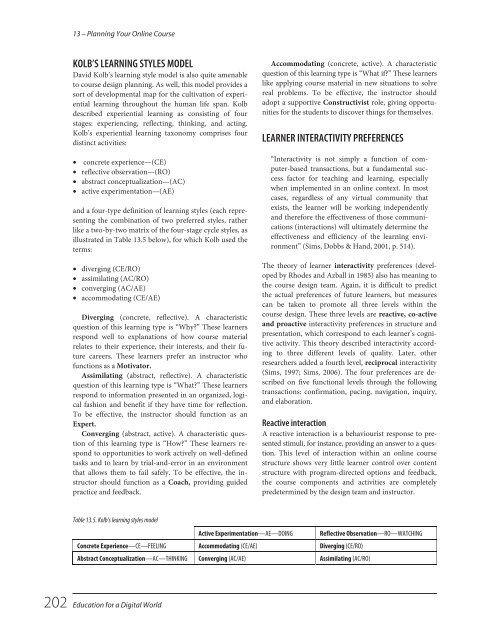Education for a Digital World Advice, Guidelines and Effective Practice from Around Globe, 2008a
Education for a Digital World Advice, Guidelines and Effective Practice from Around Globe, 2008a
Education for a Digital World Advice, Guidelines and Effective Practice from Around Globe, 2008a
You also want an ePaper? Increase the reach of your titles
YUMPU automatically turns print PDFs into web optimized ePapers that Google loves.
13 – Planning Your Online Course<br />
KOLB’S LEARNING STYLES MODEL<br />
David Kolb’s learning style model is also quite amenable<br />
to course design planning. As well, this model provides a<br />
sort of developmental map <strong>for</strong> the cultivation of experiential<br />
learning throughout the human life span. Kolb<br />
described experiential learning as consisting of four<br />
stages: experiencing, reflecting, thinking, <strong>and</strong> acting.<br />
Kolb’s experiential learning taxonomy comprises four<br />
distinct activities:<br />
• concrete experience—(CE)<br />
• reflective observation—(RO)<br />
• abstract conceptualization—(AC)<br />
• active experimentation—(AE)<br />
<strong>and</strong> a four-type definition of learning styles (each representing<br />
the combination of two preferred styles, rather<br />
like a two-by-two matrix of the four-stage cycle styles, as<br />
illustrated in Table 13.5 below), <strong>for</strong> which Kolb used the<br />
terms:<br />
• diverging (CE/RO)<br />
• assimilating (AC/RO)<br />
• converging (AC/AE)<br />
• accommodating (CE/AE)<br />
Diverging (concrete, reflective). A characteristic<br />
question of this learning type is “Why?” These learners<br />
respond well to explanations of how course material<br />
relates to their experience, their interests, <strong>and</strong> their future<br />
careers. These learners prefer an instructor who<br />
functions as a Motivator.<br />
Assimilating (abstract, reflective). A characteristic<br />
question of this learning type is “What?” These learners<br />
respond to in<strong>for</strong>mation presented in an organized, logical<br />
fashion <strong>and</strong> benefit if they have time <strong>for</strong> reflection.<br />
To be effective, the instructor should function as an<br />
Expert.<br />
Converging (abstract, active). A characteristic question<br />
of this learning type is “How?” These learners respond<br />
to opportunities to work actively on well-defined<br />
tasks <strong>and</strong> to learn by trial-<strong>and</strong>-error in an environment<br />
that allows them to fail safely. To be effective, the instructor<br />
should function as a Coach, providing guided<br />
practice <strong>and</strong> feedback.<br />
Accommodating (concrete, active). A characteristic<br />
question of this learning type is “What if?” These learners<br />
like applying course material in new situations to solve<br />
real problems. To be effective, the instructor should<br />
adopt a supportive Constructivist role, giving opportunities<br />
<strong>for</strong> the students to discover things <strong>for</strong> themselves.<br />
LEARNER INTERACTIVITY PREFERENCES<br />
“Interactivity is not simply a function of computer-based<br />
transactions, but a fundamental success<br />
factor <strong>for</strong> teaching <strong>and</strong> learning, especially<br />
when implemented in an online context. In most<br />
cases, regardless of any virtual community that<br />
exists, the learner will be working independently<br />
<strong>and</strong> there<strong>for</strong>e the effectiveness of those communications<br />
(interactions) will ultimately determine the<br />
effectiveness <strong>and</strong> efficiency of the learning environment”<br />
(Sims, Dobbs & H<strong>and</strong>, 2001, p. 514).<br />
The theory of learner interactivity preferences (developed<br />
by Rhodes <strong>and</strong> Azball in 1985) also has meaning to<br />
the course design team. Again, it is difficult to predict<br />
the actual preferences of future learners, but measures<br />
can be taken to promote all three levels within the<br />
course design. These three levels are reactive, co-active<br />
<strong>and</strong> proactive interactivity preferences in structure <strong>and</strong><br />
presentation, which correspond to each learner’s cognitive<br />
activity. This theory described interactivity according<br />
to three different levels of quality. Later, other<br />
researchers added a fourth level, reciprocal interactivity<br />
(Sims, 1997; Sims, 2006). The four preferences are described<br />
on five functional levels through the following<br />
transactions: confirmation, pacing, navigation, inquiry,<br />
<strong>and</strong> elaboration.<br />
Reactive interaction<br />
A reactive interaction is a behaviourist response to presented<br />
stimuli, <strong>for</strong> instance, providing an answer to a question.<br />
This level of interaction within an online course<br />
structure shows very little learner control over content<br />
structure with program-directed options <strong>and</strong> feedback,<br />
the course components <strong>and</strong> activities are completely<br />
predetermined by the design team <strong>and</strong> instructor.<br />
Table 13.5. Kolb’s learning styles model<br />
Active Experimentation—AE—DOING<br />
Reflective Observation—RO—WATCHING<br />
Concrete Experience—CE—FEELING Accommodating (CE/AE) Diverging (CE/RO)<br />
Abstract Conceptualization—AC—THINKING Converging (AC/AE) Assimilating (AC/RO)<br />
202 <strong>Education</strong> <strong>for</strong> a <strong>Digital</strong> <strong>World</strong>


















